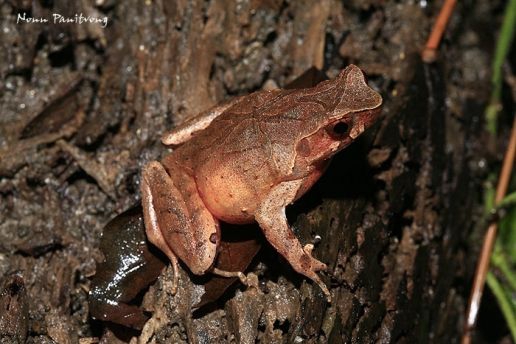| Taxon ID: 57,782 Total records: 39,143 | ||||||||||||||
Xenophrys parva
Country
| Country | Myanmar |
|---|---|
| Continent Ocean | Asia |
Classification
| Kingdom | Animalia (COL) |
|---|---|
| Phylum | Chordata (COL) |
| Class | Amphibia (COL) |
| Order | Anura (COL) |
| Family | Megophryidae (COL) |
Taxonomy
| Genus | Xenophrys | Reference | |
|---|---|---|---|
| SubGenus | Vernacular Name | ||
| Species | parva | IUCN Threat Status-Year | Least Concern, 2004 |
| SubSpecies | Nat'l Threat Status-Year | Not Evaluated, 2000 | |
| Infraspecies | Reason for Change | ||
| Infraspecies Rank | CITES | ||
| Taxonomic Group | Amphibians | Native Status | Native |
| Scientific Name Author | Boulenger, 1893 | Country Distribution | Myanmar |
| Citation | Description | Geographic Range [top]
Range Description: This species is known from Myanmar as far south as Tenasserim, northern Thailand, Phuket Island (Thailand), northern Lao Peoples Democratic Republic, northern Viet Nam, southern Yunnan and southwestern Guangxi in China, and Sikkim, West Bengal, Assam, Meghalaya, Arunachal Pradesh in India, and Bhutan and Nepal. It is known from two isolated localities in Chittagong and Chittagong Hill-tracts in Bangladesh and most likely occurs more widely in this country. It occurs at elevations of between 500 and 2,500m asl.
Countries occurrence:
Native:
Bangladesh; Bhutan; China; India; Lao Peoples Democratic Republic; Myanmar; Nepal; Thailand; Viet Nam
Additional data:
Range Map: Click here to open the map viewer and explore range.
Population [top]
Population: This is generally an uncommon species, and is rarely encountered in numbers.
Current Population Trend: Decreasing
Additional data:
? Population severely fragmented: No
Habitat and Ecology [top]
Habitat and Ecology: It is known from evergreen broadleaf forest alongside streams. Males have been observed calling from logs, bushes and rocks along streams. It is a stream-breeding amphibian.
Systems: Terrestrial; Freshwater
Threats [top]
Major Threat(s): Forest loss is ongoing within the Chinese range of the species. Localized clearance of forest habitat and agricultural pollution are threats in South Asia. In Southeast Asia stream degradation from human clearance and collection activities as well as pollution might be a threat.
Conservation Actions [top]
Conservation Actions: Its wide range and known occurrence in several protected areas throughout its range suggests that no immediate conservation measures are needed at present. Additional information on population status, distribution and biology would be useful.
Citation: Peter Paul van Dijk, Bryan Stuart, Yang Datong, Wu Guanfu, Sushil Dutta, Sabitry Bordoloi, Tej Kumar Shrestha, Saibal Sengupta, Ghazi S.M. Asmat. 2004. Megophrys parva. The IUCN Red List of Threatened Species 2004: e.T57651A11669946. http://dx.doi.org/10.2305/IUCN.UK.2004.RLTS.T57651A11669946.en. Downloaded on 22 February 2017.
Disclaimer: To make use of this information, please check the |
|
| Source |
Record Level
Growth Parameters
| Temperature | 0 | Observed Weight | 0 |
|---|---|---|---|
| Sex | Previous Catalog Number | ||
| Life Stage | Relationship Type | ||
| Preparation Type | Related Catalog Item | ||
| Individual Count | 0 | GML Features | |
| Observerd Individual Count | 0 | Notes |
Collecting Event
Images
|
Additional Info
Synonyms To Manage Synonyms for Xenophrys parva, click this link: Synonyms. |
Xenophrys monticola Günther, 1864 ¦ Xenophrys parva (Boulenger, 1893) ¦ |
Common Names To Manage Common Names for Xenophrys parva, click this link: Common Names. |
|
Localities To Manage Localities for Xenophrys parva, click this link: Localities. |
Species Record Details Encoded By:
Carlos Aurelio Callangan
|
Species Record Updated By:
Carlos Aurelio Callangan
|

